Jin Wang
University of California, Los Angeles, USA
PerchMobi^3: A Multi-Modal Robot with Power-Reuse Quad-Fan Mechanism for Air-Ground-Wall Locomotion
Sep 16, 2025Abstract:Achieving seamless integration of aerial flight, ground driving, and wall climbing within a single robotic platform remains a major challenge, as existing designs often rely on additional adhesion actuators that increase complexity, reduce efficiency, and compromise reliability. To address these limitations, we present PerchMobi^3, a quad-fan, negative-pressure, air-ground-wall robot that implements a propulsion-adhesion power-reuse mechanism. By repurposing four ducted fans to simultaneously provide aerial thrust and negative-pressure adhesion, and integrating them with four actively driven wheels, PerchMobi^3 eliminates dedicated pumps while maintaining a lightweight and compact design. To the best of our knowledge, this is the first quad-fan prototype to demonstrate functional power reuse for multi-modal locomotion. A modeling and control framework enables coordinated operation across ground, wall, and aerial domains with fan-assisted transitions. The feasibility of the design is validated through a comprehensive set of experiments covering ground driving, payload-assisted wall climbing, aerial flight, and cross-mode transitions, demonstrating robust adaptability across locomotion scenarios. These results highlight the potential of PerchMobi^3 as a novel design paradigm for multi-modal robotic mobility, paving the way for future extensions toward autonomous and application-oriented deployment.
SWIRL: A Staged Workflow for Interleaved Reinforcement Learning in Mobile GUI Control
Aug 27, 2025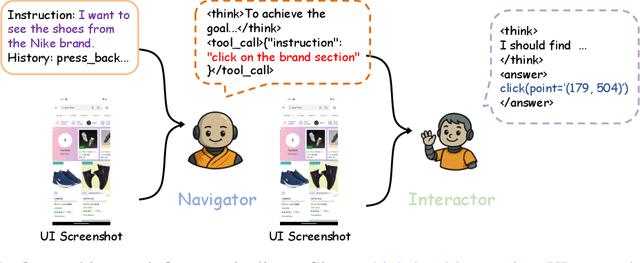
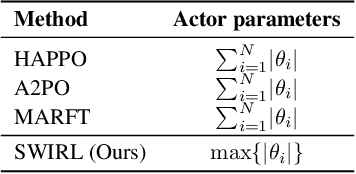
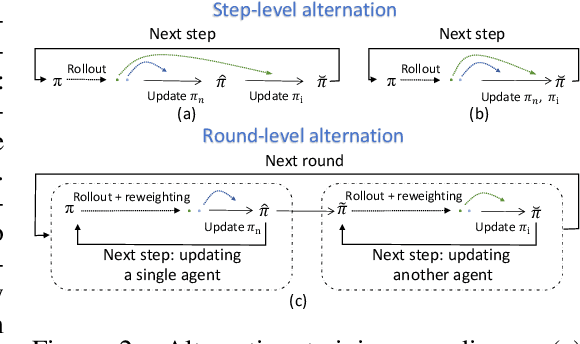

Abstract:The rapid advancement of large vision language models (LVLMs) and agent systems has heightened interest in mobile GUI agents that can reliably translate natural language into interface operations. Existing single-agent approaches, however, remain limited by structural constraints. Although multi-agent systems naturally decouple different competencies, recent progress in multi-agent reinforcement learning (MARL) has often been hindered by inefficiency and remains incompatible with current LVLM architectures. To address these challenges, we introduce SWIRL, a staged workflow for interleaved reinforcement learning designed for multi-agent systems. SWIRL reformulates MARL into a sequence of single-agent reinforcement learning tasks, updating one agent at a time while keeping the others fixed. This formulation enables stable training and promotes efficient coordination across agents. Theoretically, we provide a stepwise safety bound, a cross-round monotonic improvement theorem, and convergence guarantees on return, ensuring robust and principled optimization. In application to mobile GUI control, SWIRL instantiates a Navigator that converts language and screen context into structured plans, and an Interactor that grounds these plans into executable atomic actions. Extensive experiments demonstrate superior performance on both high-level and low-level GUI benchmarks. Beyond GUI tasks, SWIRL also demonstrates strong capability in multi-agent mathematical reasoning, underscoring its potential as a general framework for developing efficient and robust multi-agent systems.
Information-Theoretic Graph Fusion with Vision-Language-Action Model for Policy Reasoning and Dual Robotic Control
Aug 07, 2025Abstract:Teaching robots dexterous skills from human videos remains challenging due to the reliance on low-level trajectory imitation, which fails to generalize across object types, spatial layouts, and manipulator configurations. We propose Graph-Fused Vision-Language-Action (GF-VLA), a framework that enables dual-arm robotic systems to perform task-level reasoning and execution directly from RGB and Depth human demonstrations. GF-VLA first extracts Shannon-information-based cues to identify hands and objects with the highest task relevance, then encodes these cues into temporally ordered scene graphs that capture both hand-object and object-object interactions. These graphs are fused with a language-conditioned transformer that generates hierarchical behavior trees and interpretable Cartesian motion commands. To improve execution efficiency in bimanual settings, we further introduce a cross-hand selection policy that infers optimal gripper assignment without explicit geometric reasoning. We evaluate GF-VLA on four structured dual-arm block assembly tasks involving symbolic shape construction and spatial generalization. Experimental results show that the information-theoretic scene representation achieves over 95 percent graph accuracy and 93 percent subtask segmentation, supporting the LLM planner in generating reliable and human-readable task policies. When executed by the dual-arm robot, these policies yield 94 percent grasp success, 89 percent placement accuracy, and 90 percent overall task success across stacking, letter-building, and geometric reconfiguration scenarios, demonstrating strong generalization and robustness across diverse spatial and semantic variations.
INTENTION: Inferring Tendencies of Humanoid Robot Motion Through Interactive Intuition and Grounded VLM
Aug 06, 2025Abstract:Traditional control and planning for robotic manipulation heavily rely on precise physical models and predefined action sequences. While effective in structured environments, such approaches often fail in real-world scenarios due to modeling inaccuracies and struggle to generalize to novel tasks. In contrast, humans intuitively interact with their surroundings, demonstrating remarkable adaptability, making efficient decisions through implicit physical understanding. In this work, we propose INTENTION, a novel framework enabling robots with learned interactive intuition and autonomous manipulation in diverse scenarios, by integrating Vision-Language Models (VLMs) based scene reasoning with interaction-driven memory. We introduce Memory Graph to record scenes from previous task interactions which embodies human-like understanding and decision-making about different tasks in real world. Meanwhile, we design an Intuitive Perceptor that extracts physical relations and affordances from visual scenes. Together, these components empower robots to infer appropriate interaction behaviors in new scenes without relying on repetitive instructions. Videos: https://robo-intention.github.io
Privacy-preserving Preselection for Face Identification Based on Packing
Jul 03, 2025Abstract:Face identification systems operating in the ciphertext domain have garnered significant attention due to increasing privacy concerns and the potential recovery of original facial data. However, as the size of ciphertext template libraries grows, the face retrieval process becomes progressively more time-intensive. To address this challenge, we propose a novel and efficient scheme for face retrieval in the ciphertext domain, termed Privacy-Preserving Preselection for Face Identification Based on Packing (PFIP). PFIP incorporates an innovative preselection mechanism to reduce computational overhead and a packing module to enhance the flexibility of biometric systems during the enrollment stage. Extensive experiments conducted on the LFW and CASIA datasets demonstrate that PFIP preserves the accuracy of the original face recognition model, achieving a 100% hit rate while retrieving 1,000 ciphertext face templates within 300 milliseconds. Compared to existing approaches, PFIP achieves a nearly 50x improvement in retrieval efficiency.
HiBerNAC: Hierarchical Brain-emulated Robotic Neural Agent Collective for Disentangling Complex Manipulation
Jun 11, 2025Abstract:Recent advances in multimodal vision-language-action (VLA) models have revolutionized traditional robot learning, enabling systems to interpret vision, language, and action in unified frameworks for complex task planning. However, mastering complex manipulation tasks remains an open challenge, constrained by limitations in persistent contextual memory, multi-agent coordination under uncertainty, and dynamic long-horizon planning across variable sequences. To address this challenge, we propose \textbf{HiBerNAC}, a \textbf{Hi}erarchical \textbf{B}rain-\textbf{e}mulated \textbf{r}obotic \textbf{N}eural \textbf{A}gent \textbf{C}ollective, inspired by breakthroughs in neuroscience, particularly in neural circuit mechanisms and hierarchical decision-making. Our framework combines: (1) multimodal VLA planning and reasoning with (2) neuro-inspired reflection and multi-agent mechanisms, specifically designed for complex robotic manipulation tasks. By leveraging neuro-inspired functional modules with decentralized multi-agent collaboration, our approach enables robust and enhanced real-time execution of complex manipulation tasks. In addition, the agentic system exhibits scalable collective intelligence via dynamic agent specialization, adapting its coordination strategy to variable task horizons and complexity. Through extensive experiments on complex manipulation tasks compared with state-of-the-art VLA models, we demonstrate that \textbf{HiBerNAC} reduces average long-horizon task completion time by 23\%, and achieves non-zero success rates (12\textendash 31\%) on multi-path tasks where prior state-of-the-art VLA models consistently fail. These results provide indicative evidence for bridging biological cognition and robotic learning mechanisms.
Anomaly Detection and Generation with Diffusion Models: A Survey
Jun 11, 2025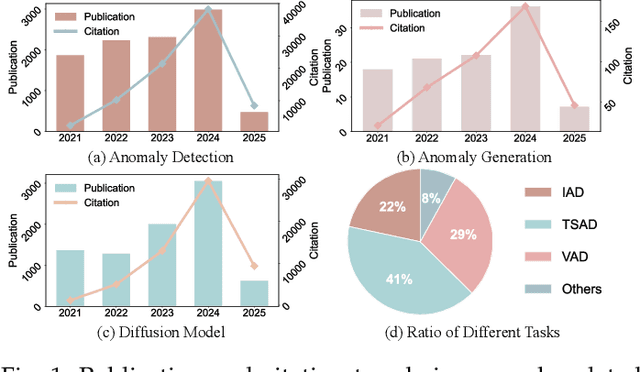

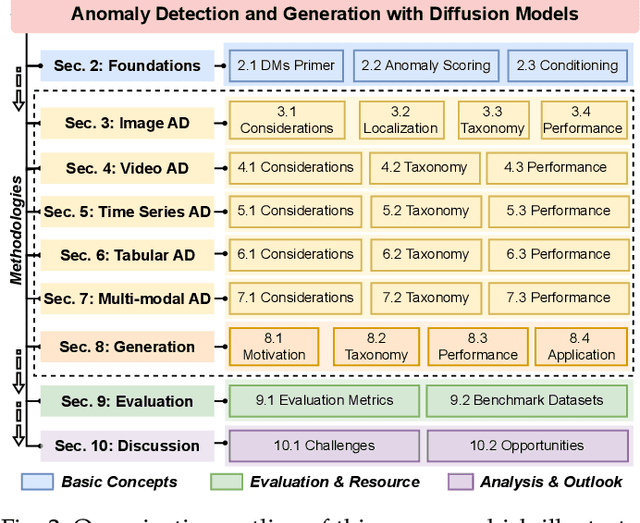

Abstract:Anomaly detection (AD) plays a pivotal role across diverse domains, including cybersecurity, finance, healthcare, and industrial manufacturing, by identifying unexpected patterns that deviate from established norms in real-world data. Recent advancements in deep learning, specifically diffusion models (DMs), have sparked significant interest due to their ability to learn complex data distributions and generate high-fidelity samples, offering a robust framework for unsupervised AD. In this survey, we comprehensively review anomaly detection and generation with diffusion models (ADGDM), presenting a tutorial-style analysis of the theoretical foundations and practical implementations and spanning images, videos, time series, tabular, and multimodal data. Crucially, unlike existing surveys that often treat anomaly detection and generation as separate problems, we highlight their inherent synergistic relationship. We reveal how DMs enable a reinforcing cycle where generation techniques directly address the fundamental challenge of anomaly data scarcity, while detection methods provide critical feedback to improve generation fidelity and relevance, advancing both capabilities beyond their individual potential. A detailed taxonomy categorizes ADGDM methods based on anomaly scoring mechanisms, conditioning strategies, and architectural designs, analyzing their strengths and limitations. We final discuss key challenges including scalability and computational efficiency, and outline promising future directions such as efficient architectures, conditioning strategies, and integration with foundation models (e.g., visual-language models and large language models). By synthesizing recent advances and outlining open research questions, this survey aims to guide researchers and practitioners in leveraging DMs for innovative AD solutions across diverse applications.
Learning to Recover: Dynamic Reward Shaping with Wheel-Leg Coordination for Fallen Robots
Jun 05, 2025Abstract:Adaptive recovery from fall incidents are essential skills for the practical deployment of wheeled-legged robots, which uniquely combine the agility of legs with the speed of wheels for rapid recovery. However, traditional methods relying on preplanned recovery motions, simplified dynamics or sparse rewards often fail to produce robust recovery policies. This paper presents a learning-based framework integrating Episode-based Dynamic Reward Shaping and curriculum learning, which dynamically balances exploration of diverse recovery maneuvers with precise posture refinement. An asymmetric actor-critic architecture accelerates training by leveraging privileged information in simulation, while noise-injected observations enhance robustness against uncertainties. We further demonstrate that synergistic wheel-leg coordination reduces joint torque consumption by 15.8% and 26.2% and improves stabilization through energy transfer mechanisms. Extensive evaluations on two distinct quadruped platforms achieve recovery success rates up to 99.1% and 97.8% without platform-specific tuning. The supplementary material is available at https://boyuandeng.github.io/L2R-WheelLegCoordination/
SwitchCodec: A High-Fidelity Nerual Audio Codec With Sparse Quantization
May 30, 2025Abstract:We present a universal high-fidelity neural audio compression algorithm that can compress speech, music, and general audio below 3 kbps bandwidth. Although current state-of-the-art audio codecs excel in audio compression, their effectiveness significantly declines when embedding space is sharply reduced, which corresponds to higher compression. To address this problem, we propose Residual Experts Vector Quantization (REVQ), which significantly expands the available embedding space and improves the performance while hardly sacrificing the bandwidth. Furthermore, we introduce a strategy to ensure that the vast embedding space can be fully utilized. Additionally, we propose a STFT-based discriminator to guide the generator in producing indistinguishable spectrograms. We demonstrate that the proposed approach outperforms baseline methods through detailed ablations.
FUDOKI: Discrete Flow-based Unified Understanding and Generation via Kinetic-Optimal Velocities
May 26, 2025Abstract:The rapid progress of large language models (LLMs) has catalyzed the emergence of multimodal large language models (MLLMs) that unify visual understanding and image generation within a single framework. However, most existing MLLMs rely on autoregressive (AR) architectures, which impose inherent limitations on future development, such as the raster-scan order in image generation and restricted reasoning abilities in causal context modeling. In this work, we challenge the dominance of AR-based approaches by introducing FUDOKI, a unified multimodal model purely based on discrete flow matching, as an alternative to conventional AR paradigms. By leveraging metric-induced probability paths with kinetic optimal velocities, our framework goes beyond the previous masking-based corruption process, enabling iterative refinement with self-correction capability and richer bidirectional context integration during generation. To mitigate the high cost of training from scratch, we initialize FUDOKI from pre-trained AR-based MLLMs and adaptively transition to the discrete flow matching paradigm. Experimental results show that FUDOKI achieves performance comparable to state-of-the-art AR-based MLLMs across both visual understanding and image generation tasks, highlighting its potential as a foundation for next-generation unified multimodal models. Furthermore, we show that applying test-time scaling techniques to FUDOKI yields significant performance gains, further underscoring its promise for future enhancement through reinforcement learning.
 Add to Chrome
Add to Chrome Add to Firefox
Add to Firefox Add to Edge
Add to Edge